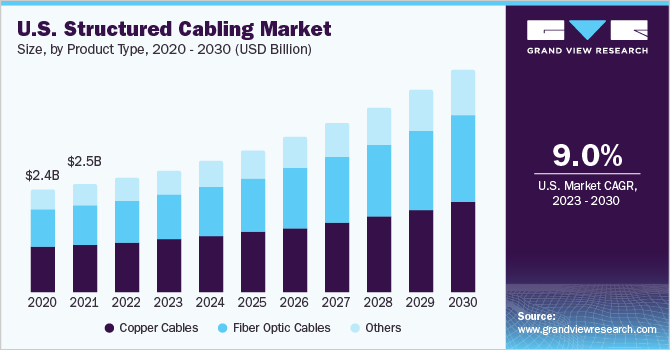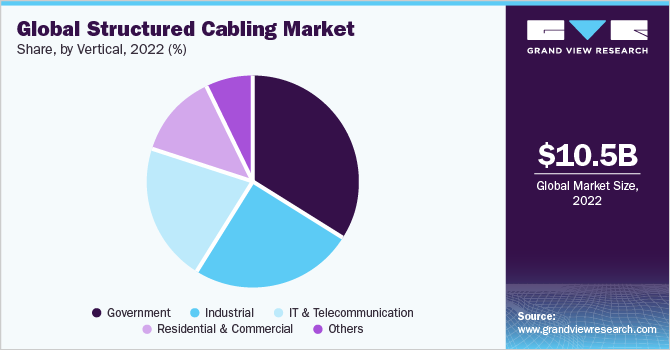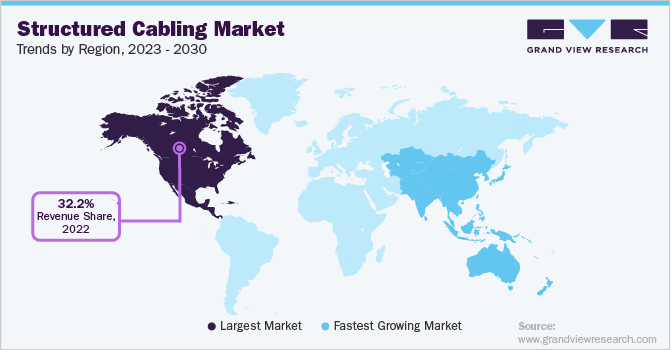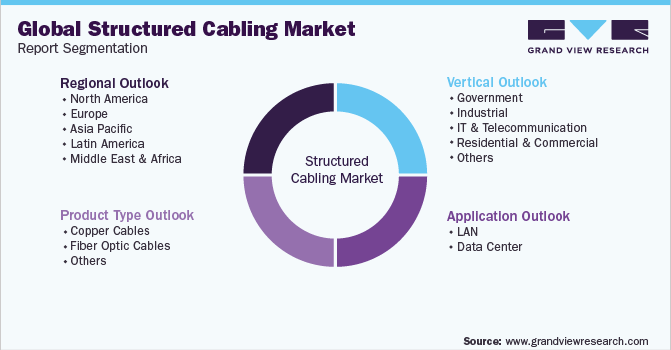- Home
- »
- Next Generation Technologies
- »
-
Structured Cabling Market Size, Share & Trends Report, 2030GVR Report cover
![Structured Cabling Market Size, Share & Trends Report]()
Structured Cabling Market Size, Share & Trends Analysis Report By Product Type (Copper Cables, Fiber Optic Cables), By Application (LAN, Data Center), By Vertical, By Region, And Segment Forecasts, 2023 - 2030
- Report ID: GVR-2-68038-134-4
- Number of Report Pages: 100
- Format: PDF, Horizon Databook
- Historical Range: 2017 - 2021
- Forecast Period: 2023 - 2030
- Industry: Technology
Report Overview
The global structured cabling market size was valued at USD 10.46 billion in 2022 and is estimated to expand at a CAGR of 10.7% over the forecast period. Structured cabling systems consist of hardware and cable that build up the telecommunication infrastructure of management systems. Telecommunication infrastructure helps transfer video, voice, and data signals from one end to another through a communication network. Different connecting devices and cables are required for a smooth network connection. The growth of internet users and the adoption of digital services has resulted in an exponential increase in the volume of sensitive data gathered by organizations. High-speed data transmission is made possible by a structured cabling system that has led to market expansion. The need for automated business processes, growing IoT data, focus on time and cost management, and escalating competition has significantly increased the demand for structured cabling systems.

Furthermore, these systems support quicker data transmission, which helps businesses increase the efficiency of their decision-making process and maximize profitability. However, the expensive expense of fiber optic cables, their incompatibility with antiquated communication infrastructure, and fluctuating copper costs threaten industry expansion.
The adoption of structured cabling systems across all industries in the North American market has been phenomenal. Due to the presence of major technology players, the region has been a pioneer in implementing new, advanced technologies. The expansion of the industry has been supported by the availability of improved technological infrastructure and dependable network connectivity across the region.
Product Type Insights
The copper cable segment dominated the market in 2022 with a market share of 49.8%. Copper cables are suitable for short and medium-distance transmission purposes. Owing to technological developments, copper cables are expected to gain preference among data centers and desktop connections and are anticipated to provide lucrative opportunities for the copper cable segment. The copper wire and cable industry is primarily driven by rising electricity demand and strong investment in building development. Furthermore, the growth of smart grids and increased investments in smart power transmission and distribution system upgrades are driving increased demand for the copper cable segment.
The fiber optic cables segment is estimated to register the highest CAGR over the forecast period. Fiber optics serve as the internet's backbone, and optical fiber cables serve as the medium for transporting data from one location to another. These cables are used in various verticals, including telecommunication, residential and commercial, government, utilities, aerospace, and private data networks. Increasing demand for high-speed Internet services is expected to be the key growth factor for the fiber optic cables segment. The growing use of new telecommunication technologies, such as 5G mobile and FTTX (Fiber-to-the-X) applications, is also expected to drive the growth of this segment.
Application Insights
The data center segment is expected to exhibit a high CAGR of over 11.3% from 2023 to 2030. The growth of structured cabling in data centers is due to the increasing use of IoT devices, mobile data, and smart applications. A significant amount of data is generated through digital devices, necessitating more storage, thus driving demand for data centers. This, in turn, increases demand for high data transmission speeds. Data center market competitors are increasing their foothold in previously untapped locations. Consequently, demand for structured cabling systems is anticipated to grow over the forecast period.
The LAN segment dominated the structured cabling market in 2022, and the trend is estimated to continue over the forecast period. Due to the increasing need for high-speed networks, the networking system is fragmented into smaller parts, with shorter cable lengths to facilitate high data speed. LAN enables a high data transmission speed, as the data is fragmented into smaller chunks. Due to the performance of several market sectors, the LAN cable market is expected to increase significantly. The CATEGORY 6 CABLE sector will be the fastest-growing segment among others, contributing more to the growth of the LAN Cable market.
Vertical Insights
The IT and telecommunications segment dominated the market in 2022 with a share of around 35%. Technological innovations in the telecommunications sector, such as the 5G network, require high bandwidth and low latency provided by structured cabling systems. This drives the market over the forecast period.

The industrial segment is expected to grow significantly over the coming years owing to the rising development and use of automation techniques across industries. The segment comprises small and large enterprises using structured cabling systems for connecting machinery and other automation purposes. Additionally, the increasing need for high-speed machine-to-machine communication and reliability is expected to drive the market.
Regional Insights
The North America region accounted for the highest share in the market at 32.2% in 2022 and is expected to continue its domination throughout the forecast period. The region has many leading players, such as ABB; Belden Inc.; Corning Incorporated; Furukawa Electric Co., Ltd.; Legrand SA; Nexans; and Schneider Electric. High growth in the region can be attributed to the high concentration of manufacturing and telecommunications industries that majorly adopt structured cabling systems. Technological proliferation increased the adoption of fiber optic cables, high penetration of digital services, and early adoption of advanced technologies in various verticals such as government, residential and commercial, and transportation and logistics has triggered market growth.

Asia Pacific is expected to emerge as the fastest-growing regional market, with a CAGR of 12.5% over the forecast period. The major factors such as government initiatives to promote advanced infrastructure, digitization, accelerated adoption of smart devices, rising population, and investments in cloud and IoT technologies are expected to contribute to the regional market's growth. Developing economies such as China and Japan are leading the APAC region. The increasing Internet use in these countries is resulting in a rising number of broadcast activities. This, in turn, is expected to drive the regional market's growth over the forecast period.
Key Companies & Market Share Insights
The market is highly competitive owing to the presence of various prominent players. Players have adopted strategies such as agreements, expansions, collaborations, and joint ventures. They are engaging in developing new products with high speed and improved features to enhance their product portfolio and hold a strong position in the market. For instance, in February 2021, Legrand announced the acquisition of the Champion ONE (C1) family of brands, one of the prominent suppliers for optical networking components and solutions for the data center, enterprise, and telecommunication markets.
In another instance, In September 2021, Nexans SA announced that it had agreed to the acquisition of Centelsa, the manufacturer of premium cable in Latin America active in producing cables for Building and utility applications.
Companies have also obtained approvals from different governments to launch products that can provide high speed and security. Some prominent players in the global structured cabling market include:
-
ABB Ltd
-
Belden Inc.
-
CommScope Holding Company, Inc.
-
Corning Incorporated
-
Furukawa Electric Co., Ltd.
-
Legrand SA
-
Nexans
-
Schneider Electric
-
Siemens AG
Structured Cabling Market Report Scope
Report Attribute
Details
Market size value in 2023
USD 11.35 billion
Revenue forecast in 2030
USD 23.17 billion
Growth Rate
CAGR of 10.7% from 2023 to 2030
Base year for estimation
2022
Historical data
2017 - 2021
Forecast period
2023 - 2030
Quantitative units
Revenue in USD million and CAGR from 2023 to 2030
Report coverage
Revenue forecast, company ranking, competitive landscape, growth factors, and trends
Segments covered
Product type, application, vertical, region
Regional scope
North America; Europe; Asia Pacific; Latin America; MEA
Country scope
U.S.; Canada; U.K.; Germany; France; China; Japan; India; South Korea; Australia; Brazil; Mexico; KSA; UAE; South Africa
Key companies profiled
ABB Ltd.; Belden Inc.; CommScope Holding Company, Inc.; Corning Incorporated; Furukawa Electric Co., Ltd.; Legrand SA; Nexans; Schneider Electric; Siemens AG
Customization scope
Free report customization (equivalent up to 8 analysts working days) with purchase. Addition or alteration to country, regional, and segment scope.
Pricing and purchase options
Avail customized purchase options to meet your exact research needs. Explore purchase options
Global Structured Cabling Market Report Segmentation
This report forecasts revenue growth at global, regional, and country levels and provides an analysis of the latest industry trends in each of the sub-segments from 2017 to 2030. For this study, Grand View Research has segmented the global structured cabling market based on product type, vertical, application and region.

-
Product Type Outlook (Revenue, USD Million, 2017 - 2030)
-
Copper Cables
-
Fiber Optic Cables
-
Others
-
-
Application Outlook (Revenue, USD Million, 2017 - 2030)
-
LAN
-
Data Center
-
-
Vertical Outlook (Revenue, USD Million, 2017 - 2030)
-
Government
-
Industrial
-
IT & Telecommunication
-
Residential & Commercial
-
Others
-
-
Regional Outlook (Revenue, USD Million, 2017 - 2030)
-
North America
-
U.S.
-
Canada
-
-
Europe
-
Germany
-
U.K.
-
France
-
-
Asia Pacific
-
China
-
Japan
-
India
-
South Korea
-
Australia
-
-
Latin America
-
Mexico
-
Brazil
-
-
Middle East and Africa
-
Kingdom of Saudi Arabia (KSA)
-
UAE
-
South Africa
-
-
Frequently Asked Questions About This Report
b. The global structured cabling market size was estimated at USD 10.46 billion in 2022 and is expected to reach USD 11.35 billion in 2023.
b. The global structured cabling market is expected to grow at a compound annual growth rate of 10.7% from 2023 to 2030 to reach USD 23.17 billion by 2030.
b. The IT and telecommunications segment dominated the structured cabling market in 2021 with a share of 35.3%. This is attributable to the technological innovations in the telecommunications sector, such as the 5G network, which require high bandwidth and low latency, which are provided by structured cabling systems.
b. Some key players operating in the structured cabling market include ABB; Belden Inc.; CommScope Holding Company, Inc.; Corning Incorporated; Furukawa Electric Co., Ltd.; Legrand SA; Nexans; Schneider Electric; and Siemon.
b. Key factors that are driving the structured cabling market growth include increased emphasis on cost and time management, growing IoT data, the need for automation of businesses, and increasing competition.
Share this report with your colleague or friend.
![gvr icn]()
NEED A CUSTOM REPORT?
We can customize every report - free of charge - including purchasing stand-alone sections or country-level reports, as well as offer affordable discounts for start-ups & universities. Contact us now
![Certified Icon]()
We are GDPR and CCPA compliant! Your transaction & personal information is safe and secure. For more details, please read our privacy policy.
We are committed towards customer satisfaction, and quality service.
"The quality of research they have done for us has been excellent."





